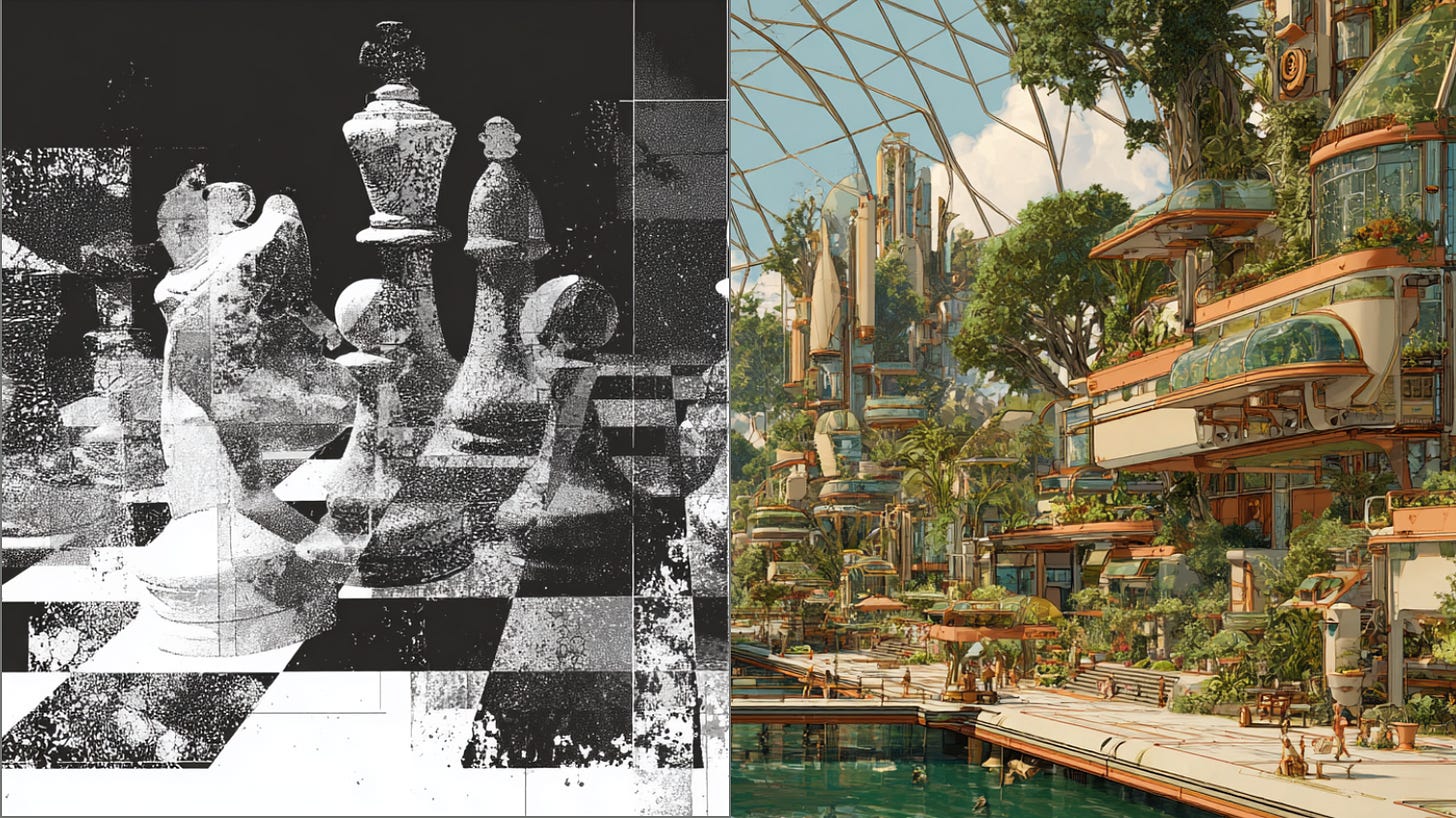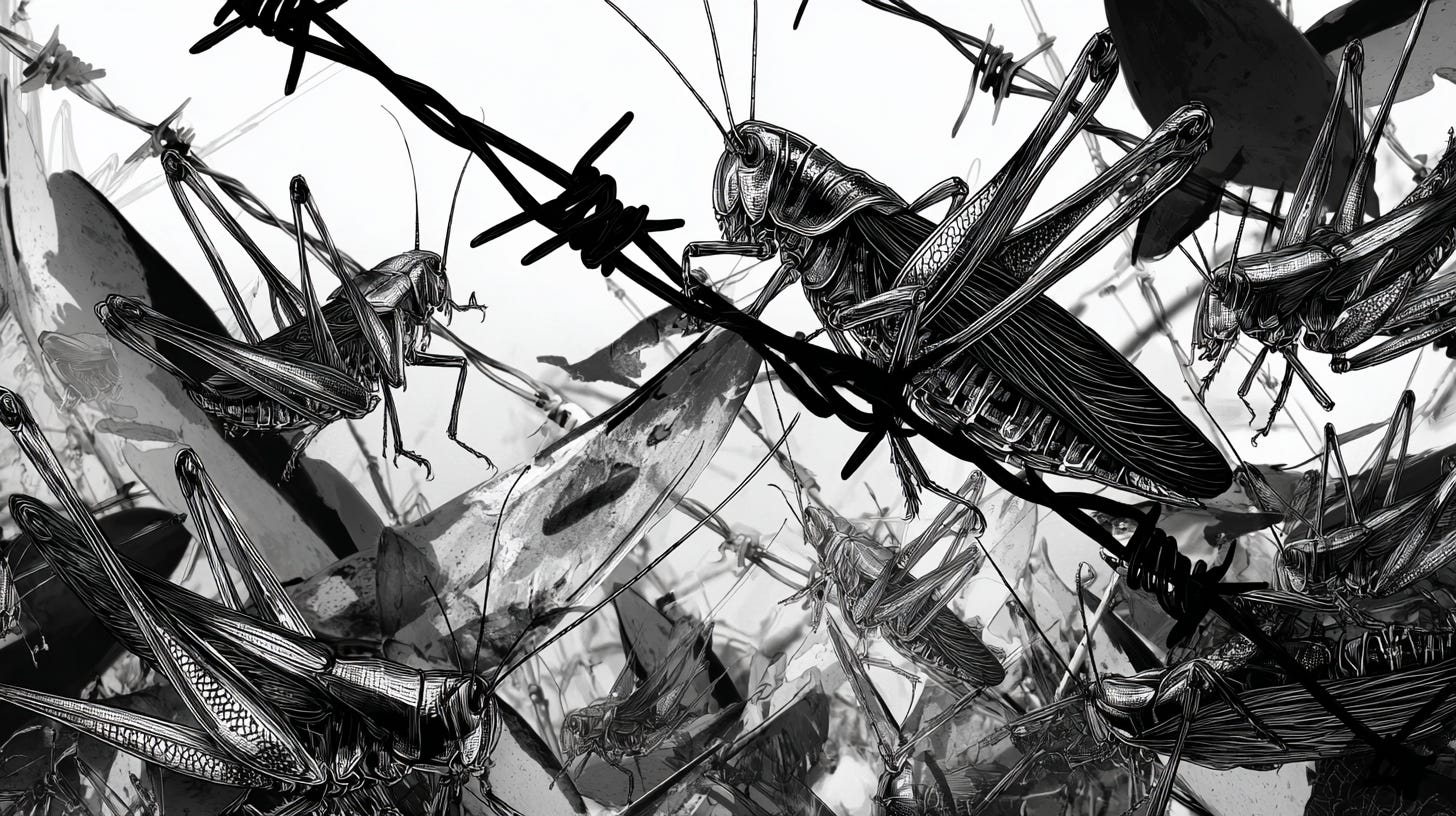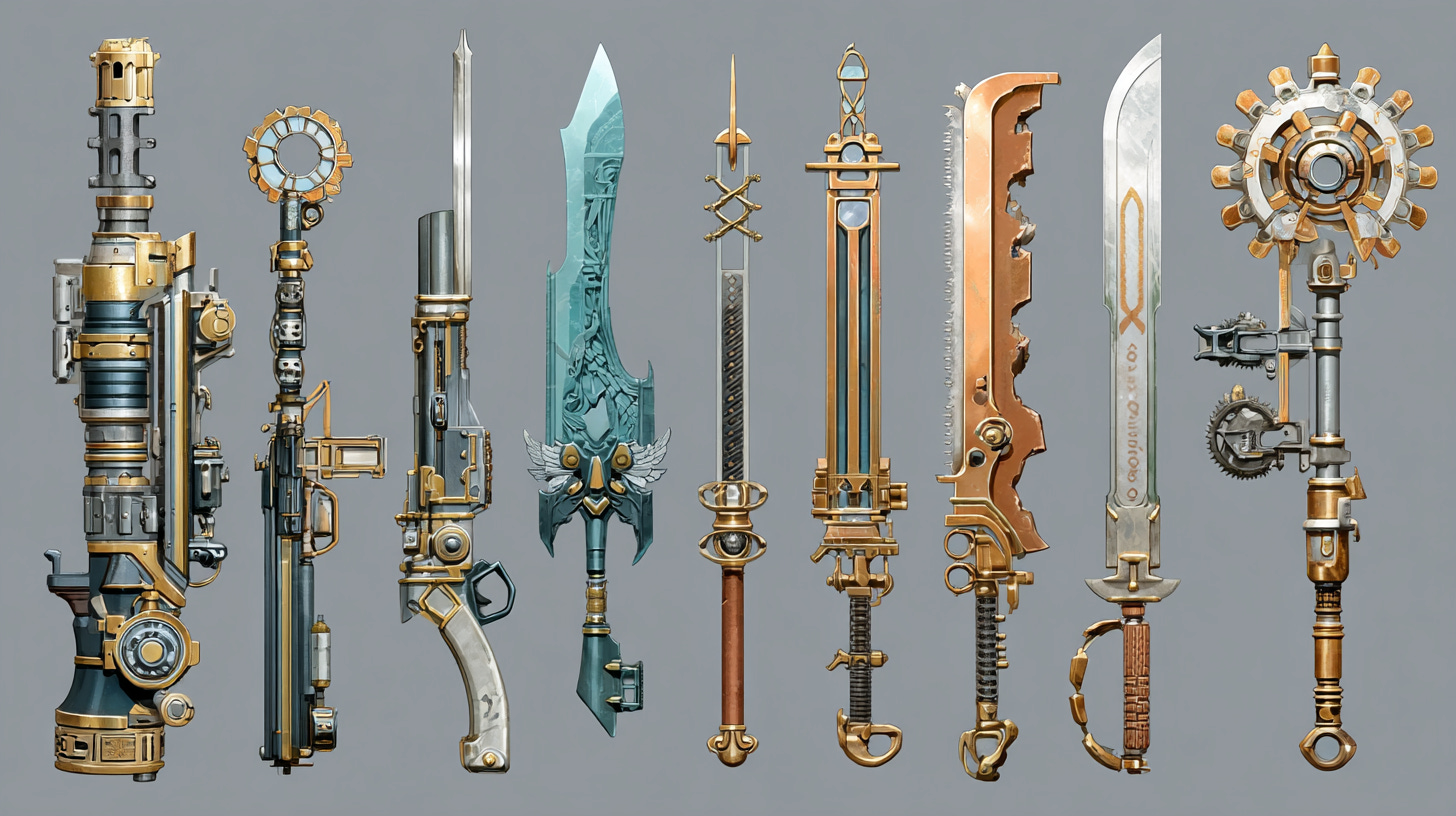New Game+ and Binding the Machiavellian Arms Race
How Can the Good Guys Win?
This piece was co-composted with Welf von Hören
Here's the problem with trying to fix capitalism: every time you try to be good, someone else gets rich by being bad. You only use sustainable suppliers, your competitor beats you on cost. You cap the profit of your company, your competitor raises more money. Your employees are in therapy, the competition grinds 80-hour workweeks.
How could the Good Guys possibly win in a hyper-competitive environment? The answer is to continue competing while secretly playing a different game.
The Trap: Machiavellian Arms Race
The Good Guys losing against cut-throat competitors is not just a problem in business. We see the same pattern again and again, from the AI arms race to politics. If you care about anything else other than winning, you are liable to lose against somebody who exclusively optimizes for power. Joe Carlsmith warns against “Locusts” in a post-AGI world, a superintelligent AI that follows a power-maximization and resource acquisition strategy.
I call this problem the “Machiavellian Arms Race” because Machiavelli already framed it correctly in the context of politics: In a world where some actors will use any means necessary to gain power, those who voluntarily constrain themselves with moral limits will be systematically defeated. This creates what Machiavelli saw as politics' core tragedy: good people cannot both remain good and in power. And he saw no way out. So he proceeded to advise his prince on how to win these power games. Use force like a lion and cunning like a fox, etc.
The Machiavellian Arms Race is Moloch in a suit. It's a ruthless competition for power in its purest forms: political power, capital, and intelligence.
But Machiavelli missed something. He was thinking like a game theorist trapped inside a single game. What if the real move is to start playing an entirely different game?
The Escape: New Game +
In gaming culture, New Game+ refers to replaying the game from the start, but with increased difficulty and retaining some of the tools and skills from the previous run. Similarly, we can compete without joining the race to the bottom and compromising on our values. It’s harder than just maximizing for winning directly, but we also get a few tricks that the power players don’t have. The metaphor also works because, realistically, you’re only in a position to play this changed version of the game after you’ve had some success in the standard game, meaning enough resources (financial, social, emotional) to not feel existentially pressured to join the arms race.
Hanzi Freinacht nailed the two ways this goes wrong: "Game denial" means pretending the arms race doesn't exist (hello, leftist coops), which leaves you pure but powerless. "Game acceptance" means joining the race to the bottom until you become the thing you were fighting. What we need is "Game Change": a secret third thing that wins against pure power without getting dragged into the mud with them.
We can win at New Game+ by leveraging our unique advantages over the locusts and gradually changing the game's rules in our favor.
Legendary Weapons
What unique advantages do the Good Guys have? Think of a company that implemented measures suggested previously. How can Patagonia win against Zara?
Let’s start with employee well-being and development. Why did the amount of beanbags and fussball tables per employee keep increasing throughout the history of tech from Intel to Google? Because of the core insights that happier, more balanced employees do better work. The most important capacity of a company in tech is not how many hours employees grind, but how significant their innovations are. Disruptive innovation (as opposed to incremental innovation) requires a work culture that encourages continuous development and blue sky thinking, not racing down a clearly defined path.
While taking into account externalities sets additional constraints (playing the game on hard mode), it can also act as creative constraints. Only using recycled plastic requires coming up with new production methods and can result in novel aesthetics.
Locusts sprint faster, but they're optimizing for a 100-meter dash in what turns out to be a marathon. New Game+ is better at long-term thinking. It doesn’t matter how fast you run if you’re running in the wrong direction. Making more deliberate decisions, including all stakeholders, is more effective than defaulting on what’s most profitable next quarter. Power players might sprint faster, but our wise warriors of the light can outrun them in a marathon.
Finally, if a company can credibly signal that they care about more than profit (e.g. by explicitly capping their profit), they will generate goodwill and unexpected allies. Employees will trade off salary with value-alignment, and customers will pay more for sustainable products.
Just like two Zen masters on the street, New Game + players need no introduction. They spot each other across a crowded conference full of growth hackers. And they will help each other out beyond instrumental alliances, creating a self-organising cooperation network invisible to power players. The Freemasons of today don’t require secrecy because power players are too fixated on scoring the next point to notice them. Dedication to higher values enables bottom-up coordination. Meanwhile, the locusts can only coordinate through top-down coercion or deals at arm’s length (ready to backstab at the first opportunity).
Value-alignment provides the basis for bottom-up coordination unavailable to pure power players.
These aren’t tactics that locusts could just copy to compete. Genuine value alignment can’t be faked. While superficial mimicry (think greenwashing) is possible, the only way to pull off a convincing imitation is to use costly signals, i.e. actually become more value-aligned. The moment they genuinely prioritize long-term stakeholder value over short-term power maximization, they've already switched games. Instead of falling into the trap of joining the arms race, we can create our own trap for pure power players: they can see the advantages but can't access them without abandoning the very optimization target that defines them. Just like coordination between single cells enabled the advent of much more complex multi-cellular organisms, value alignment could enable a similar transition.
This sounds almost too good to be true. That's because we haven't yet faced the hardest part: The most ambitious AI hyperscalers don’t have any beanbags, just ridiculously high sign on bonuses. What happens when you encounter pure power players who refuse to play any game but power maximization?
Binding the Arms Race
Even if OpenAi engineers are using a daylight computer with a sharpened mind fresh out of Jhana 4; if they are racing towards unsafe ASI, we’re still fucked.
The key to getting out of arms races is the recognition that neither party really wants to be in that situation. Even the most cut-throat AI labs would prefer not to accidentally end the world. Nobody wants nuclear war or climate change. Arms races happen because players don't trust that competitors won't defect first. “If we don’t go full speed ahead, we'll lose to competitors who are worse than us. So we have no choice”, goes every single player.
The prisoner’s dilemma is only a dilemma if the players can’t trust each other. It’s not an accident that the players in the thought experiment are criminals. The way out of the dilemma is to make small moves that can increase trust while still remaining competitive (see Schelling’s “Strategy and Conflict” for more):
Transparency and verification increase trust through costly signals. In AI, this means open technical standards and independent oversight that can be taken seriously because they're expensive to fake.
Communication and collaboration shift the frame from zero-sum to positive-sum. Joint research initiatives on AI safety and issue-based collaboration (e.g. climate or cancer research) create shared stakes while increasing the cost of defection.
In iterative prisoner’s dilemmas, tit-for-tat is a winning strategy. The strategy starts off with a cooperative move, but will punish defection with retribution. It moves back to cooperation immediately after a cooperative move from the defector.
As soon as we extend the frame of the prisoner’s dilemma over time instead of a one-off, a strategy that defaults to cooperation and has built-in forgiveness wins even in a strict game theory context. To get out of an arms race, make the first collaborative move without being a push over, meeting defection with a measured response while intending to shift back to collaboration.
The best way to win the power game is to stop playing it.
Modding the Game Play
So we've established that the Good Guys have some aces up their sleeves. But how does this actually change the game at scale?
Just like people didn’t know to ask for model Ts or iPhones, they didn’t know what they missed before the wave of New Game + products hit their shopping carts. Omni-consideration leads to products that support the development of their users, even if they are not deliberately framed that way. Daylight computers and calm technology more broadly are examples. Once you’ve tasted technology that is genuinely serving you and your highest values, you won’t go back.
People are hungry to level up. The rise of the coaching and online education industries highlights the demand for products and services that are directly aimed at personal development. Rising stars like Jhourney and Art of Accomplishment are examples.
As culture shifts, so does demand. Just like organic food, personal development is becoming a status symbol. Meditation and therapy have not only stopped being weird, but they are a staple in progressive circles. Yoga mats have become a more popular backdrop for Instagram influencers than sports cars. Growth-washing is the new greenwashing. While much of this is posing, the trend toward inner development is genuine. As consumers become more psychologically resilient, they will demand products aligned with New Game+.
If a shift in consumer preference is deep enough, it has structural implications. When Tesla made electric cars desirable, it forced every legacy automaker to retool their entire supply chain, R&D pipeline, and brand identity. The "rules of the game" aren't just about what products sell, but also about what constitutes a legitimate business strategy. When Patagonia caps its profits and still outperforms fast fashion, it demonstrates that the old game was artificially constraining the solution space. Suddenly, "maximizing shareholder value" starts looking less like natural law and more like a weird 20th-century obsession.
Maximum competitive advantage comes from minimizing competitive thinking.
Once New Game+ success stories become impossible to ignore and we have undeniable proof that value-aligned companies can outcompete pure extractors across multiple industries and time horizons, the burden of proof flips. Now it's the locusts who have to justify why they're still playing the old game.
This is why the coordination aspect is critical: it's not enough for individual companies to succeed. You need enough simultaneous proof points that the pattern becomes obvious to everyone. Once McKinsey consultants start recommending profit caps, you know the rules have fundamentally shifted.
Game change will happen once the inherent feedback loops accelerate: Wise players create companies and products that support the development of their employees and users, which generate more wise players. As consumers break free from confusion and addiction loops, they increasingly demand Good products. Even those still competing for status contribute by making development desirable.
Those who have genuinely moved beyond scarcity thinking become a new kind of economic actor. They cooperate without enforcement mechanisms, and optimize for flourishing rather than winning. Scale that up and you get workforces that coordinate without command-and-control hierarchies, customers who support durability over disposability, and investors who think beyond financial capital.
As this flywheel starts spinning, more and more humans join the open conspiracy of New Game +.
Foundational Assumption: The Good
You may have noticed that I used capitalized "Good." More than a stylistic flourish, it's the load-bearing assumption that makes everything else possible. Without that shared foundation, bottom-up coordination becomes impossible, and binding arms races reduces to wishful thinking.
New Game+ only works if there are shared values that rational actors can recognize and coordinate around.
We don’t need some platonic ideal of the Good, but we do need a value gradient we can all perceive.
This is why New Game+ ultimately requires something like religious faith. Not faith in specific doctrines, but faith in the existence of a Good that transcends individual preferences and cultural construction. The moment you believe we can move towards non-arbitrary notions of flourishing, beauty, and truth, cooperation becomes possible across ideological divides.
There is another leap of faith required: to win New Game+, the player must be able to accept the possibility of defeat in the game of power. Yes, even if that means that the bad guys could end up taking over the world and destroying what we value most. The fear of societal collapse is the social equivalent of the fear of death, so this is no small feat. However, it's that very fear that traps us in arms races, leading to worse outcomes for everyone.
To get out of the prisoner's dilemma, you have to believe in a higher value outside of the immediate frame of the game (and that others will eventually recognize that too). Our greatest hope for game change is that enough players remember what the game was supposed to be for.











Knowing there is an alternative to the Prisoners Dilemma and winner-take-all zero sum games is a key step. Once experienced, a successful Stag or Mammoth Hunt, where winners share all equitably, provides a clear upgrade in expected value through alignment. Intrinsic coordination then becomes much more likely.
Game designer Matt Leacock has been focused on this style of cooperative game, introducing this experience to a wide, family friendly context. His latest is a complex, narrative masterpiece based on the LOTR:
https://boardgamegeek.com/boardgame/436217/the-lord-of-the-rings-fate-of-the-fellowship
For lighter family fare along a similar theme, I’d highly recommend https://boardgamegeek.com/boardgame/429293/the-fellowship-of-the-ring-trick-taking-game
Coordination and sublimation of selfish desires takes play practice.